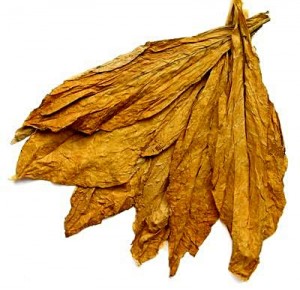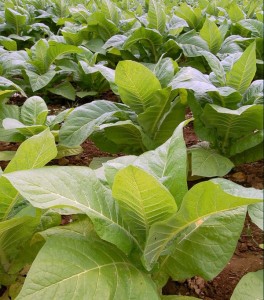 Tobacco is an agricultural product processed from the leaves of plants in the genus Nicotiana. Tobacco is cultivated similarly to other agricultural products. Tobacco is an annual crop, which is usually harvested mechanically or by hand. After harvest, tobacco is stored for curing, which allows for the slow oxidation and degradation of carotenoids. This allows for the agricultural product to take on properties that are usually attributed to the “smoothness” of the smoke. Following this, tobacco is packed into its various forms of consumption, which include smoking, chewing, sniffing, and so on.
Tobacco is an agricultural product processed from the leaves of plants in the genus Nicotiana. Tobacco is cultivated similarly to other agricultural products. Tobacco is an annual crop, which is usually harvested mechanically or by hand. After harvest, tobacco is stored for curing, which allows for the slow oxidation and degradation of carotenoids. This allows for the agricultural product to take on properties that are usually attributed to the “smoothness” of the smoke. Following this, tobacco is packed into its various forms of consumption, which include smoking, chewing, sniffing, and so on.
Tobacco is a high-value cash crop which is planted throughout the country. It grows on a wide variety of soils under dry land conditions or irrigation.
Production of Tobacco
Uses
- Pipe and chewing tobacco
- Snuff
- Tobacco dusts (scraps which are not used) are sold at nurseries to repel insects
Soil and Climatic Requirements
Tobacco can be cultivated under dryland conditions or irrigation on any soil type. Irrigation is, however, preferred.
The crop prefers long, hot summers and is susceptible to wind damage. Tobacco plants are very sensitive to frost.
Planting
- Cultivars – Only one cultivar, namely CDL 28 is available commercially.
- Preparing the seedbed – Tobacco can be planted on level soils or on ridges. Ridging is preferred if the soil tends to get waterlogged or in very shallow soils. Use existing methods of cultivating the soil before planting.
- Planting time – The crop has a growth season of approximately 90 days from planting to harvesting. When deciding on a planting date the onset of frost should be taken into account.

Fertilization
Tobacco plants require large quantities of nitrogen as it determines the quality of the end product. A crop rotation system should preferably be used. Although a legume crop does not necessarily have to form part of the crop rotation system it is, however, recommended for nitrogen fixation. It is important to include a crop in the system which has a repressive effect on nematodes eg oats, sunnhemp or marigold. To reduce fertilization costs organic fertilizers can be applied.
Planting Method
The tobacco crop is established using seedlings. Climate is of paramount importance to germination and growth of the seedlings and should be kept in mind when producing seedlings. Seedlings are planted manually.
Plant Spacing
Plant 10 000 to 12 000 seedlings/ha. To facilitate the movement of implements, rows should be spaced approximately 1,2 m apart. An in-row spacing of 60 cm is recommended.
Pest Control
- Weeds – Chemical control. Weeds can also be pulled up by hand.
- Insects – Insect pests are limited to certain areas and can be controlled chemically or manually. The latter method can only be used in small areas. Chemical control is very effective.
- Diseases – Tobacco is susceptible to various diseases. Consult an expert in this regard.
Topping and Suckering
- Topping – The plants are topped (reproductive parts are removed) at a height of between 18 to 22 leaves to stimulate leaf growth.
- Suckering – Because the flowers (reproductive parts) have been removed, suckers sprout from each axil. These suckers can be controlled chemically or removed by hand.
Harvesting
The whole plant is chopped down and suspended to dry as soon as physiological maturity is reached. When the entire plant is dry, it is moistened. Picking and classing is then done.
Marketing
Tobacco can be marketed formally as well as informally.
Source : http://www.nda.agric.za; Photos: wikipedia.org and fotolia.com